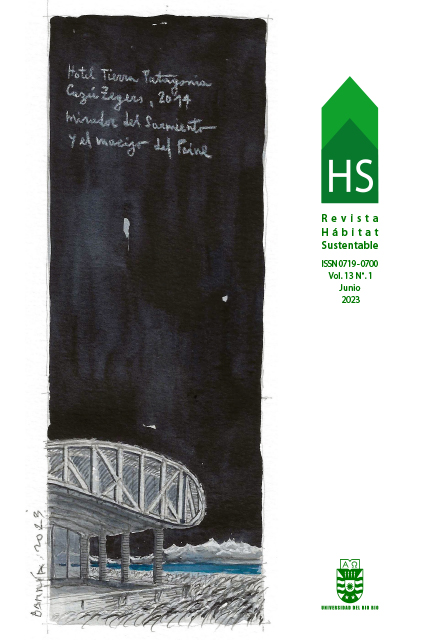Viabilidad del modelo de confort térmico adaptativo bajo condiciones de clima cálido subhúmedo: Ahorro energético en refrigeración en Campeche, México
DOI:
https://doi.org/10.22320/07190700.2023.13.01.10Palabras clave:
confort térmico adaptativo, clima cálido subhúmedo, ahorro energéticoResumen
El enfoque convencional para alcanzar el confort térmico generalmente se centra en modificar la temperatura de consigna en edificios totalmente climatizados. Sin embargo, el enfoque del confort térmico adaptativo es una alternativa que considera la interacción entre los edificios, el clima local y los usuarios para permitir mejoras significativas en el ahorro de energía. El trabajo analiza la viabilidad de implementar estrategias de confort térmico adaptativo, comparando modelos adaptativos basados en la norma ASHRAE 55-2020 y un modelo regional para la tipología climática tropical de México, contrastando los resultados respecto del enfoque estático. Se analizó térmicamente 13 locaciones del Estado de Campeche obteniendo que las estrategias de ventilación son aplicables en todo el Estado y que ambos modelos aseguran mejoras en el consumo de energía. Además, los resultaron siguieren que es necesario desarrollar más modelos adaptativos locales para proponer estrategias con mejor potencial de impacto en la región.
Descargas
Citas
ANSI/ASHRAE. (2021). ANSI/ASHRAE Standard 169-2020 - Climatic Design Building Standards. Recuperado de: https://www.ashrae.org/file%20library/technical%20resources/standards%20and%20guidelines/standards%20addenda/169_2020_a_20211029.pdf
ASHRAE. (2020). ASHRAE Standard 55-2020 - Thermal Environmental Conditions for Human Occupancy. Recuperado de: https://www.ashrae.org/file%20library/technical%20resources/standards%20and%20guidelines/standards%20addenda/55_2020_a_20210430.pdf
BIENVENIDO-HUERTAS, D., PULIDO-ARCAS, J. A., RUBIO-BELLIDO, C. & PÉREZ-FARGALLO, A. (2021). Feasibility of adaptive thermal comfort for energy savings in cooling and heating: A study on Europe and the Mediterranean basin. Urban Climate, 36, 100807. DOI: https://doi.org/10.1016/j.uclim.2021.100807
CARLUCCI, S., BAI, L., DE DEAR, R. & YANG, L. (2018). Review of adaptive thermal comfort models in built environmental regulatory documents. Building and Environment, 137, 73-89. DOI: https://doi.org/10.1016/j.buildenv.2018.03.053
HOYT, T., ARENS, E. & ZHANG, H. (2015). Extending air temperature setpoints: Simulated energy savings and design considerations for new and retrofit buildings. Building and Environment, 88, 89-96. DOI: https://doi.org/10.1016/j.buildenv.2014.09.010
HUMPHREYS, M. S., NICOL, J. M. & RAJA, I. A. (2007). Field Studies of Indoor Thermal Comfort and the Progress of the Adaptive Approach. Advances in Building Energy Research, 1(1), 55-88. DOI: https://doi.org/10.1080/17512549.2007.9687269
INEGI. 2022. Aspectos Geográficos: Campeche 2021. Aguascalientes.
JIMENEZ-TORRES, M., BIENVENIDO-HUERTAS, D., MAY TZUC, O., BASSAM, A., RICALDE CASTELLANOS, L. J. & FLOTA-BAÑUELOS, M. (2023). Assessment of climate change’s impact on energy demand in Mexican buildings: Projection in single-family houses based on Representative Concentration Pathways. Energy for Sustainable Development, 72, 185-201. DOI: https://doi.org/10.1016/j.esd.2022.12.012
OROPEZA-PEREZ, I., PETZOLD-RODRIGUEZ, A. H. & BONILLA-LOPEZ, C. (2017). Adaptive thermal comfort in the main Mexican climate conditions with and without passive cooling. Energy and Buildings, 145, 251-258. DOI: https://doi.org/10.1016/j.enbuild.2017.04.031
PÉREZ-FARGALLO, A., BIENVENIDO-HUERTAS, D., RUBIO-BELLIDO, C. & TREBILCOCK, M. (2020). Energy poverty risk mapping methodology considering the user’s thermal adaptability: The case of Chile. Energy for Sustainable Development, 58, 63-77. DOI: https://doi.org/10.1016/j.esd.2020.07.009
RODRÍGUEZ, C. M. & D’ALESSANDRO, M. (2019). Indoor thermal comfort review: The tropics as the next frontier. Urban Climate, 29, 100488. DOI: https://doi.org/10.1016/j.uclim.2019.100488
SALA, M., GALLO, C. & SAYIGH, A. A. M. (1999). Architecture - Comfort and Energy. Elsevier.
SALCIDO, J. C., RAHEEM, A. A. & ISSA, R. R. A. (2016). From simulation to monitoring: Evaluating the potential of mixed-mode ventilation (MMV) systems for integrating natural ventilation in office buildings through a comprehensive literature review. Energy and Buildings, 127, 1008-1018. DOI: https://doi.org/10.1016/j.enbuild.2016.06.054
SÁNCHEZ-GARCÍA, D., BIENVENIDO-HUERTAS, D., PULIDO-ARCAS, J. A. & RUBIO-BELLIDO, C. (2023). Extending the use of adaptive thermal comfort to air-conditioning: The case study of a local Japanese comfort model in present and future scenarios. Energy and Buildings, 285, 112901. DOI: https://doi.org/10.1016/j.enbuild.2023.112901
SÁNCHEZ-GARCÍA, D., RUBIO-BELLIDO, C., MARTÍN DEL RÍO, J. J. & PÉREZ-FARGALLO, A. (2019). Towards the Quantification of Energy Demand and Consumption through the Adaptive Comfort Approach in Mixed Mode Office Buildings Considering Climate Change. Energy and Buildings 187, 173-85. DOI: https://doi.org/10.1016/j.enbuild.2019.02.002
SENER, Secretaria Nacional de Energía. (2021). Comisión Nacional Para el uso Eficiente de la Energía. Infografía Confort Térmico. Recuperado de: https://www.gob.mx/conuee/acciones-y-programas/estadisticas-energeticas-en-las-viviendas-mexicanas
TSOLKAS, C., SPILIOTIS, E., SARMAS, E., MARINAKIS, V. & DOUKAS, H. (2023). Dynamic energy management with thermal comfort forecasting. Building and Environment, 237, 110341. DOI: https://doi.org/10.1016/j.buildenv.2023.110341
YAU, Y. H. & CHEW, B. P. (2012). A review on predicted mean vote and adaptive thermal comfort models. Building Services Engineering Research and Technology, 35(1), 23-35. DOI: https://doi.org/10.1177/0143624412465200
Descargas
Publicado
Cómo citar
Número
Sección
Licencia
Derechos de autor 2023 Oscar May-Tzuc, Mario Antonio Jiménez-Torres, Andrea del Rosario Cruz y Cruz, Román Canul-Turriza, Juan Edgar Andrade-Durán, Felipe Noh-Pat

Esta obra está bajo una licencia internacional Creative Commons Atribución-CompartirIgual 4.0.
El contenido de los artículos que se publican en cada número de Hábitat Sustentable, es responsabilidad exclusiva de los autores y no representan necesariamente el pensamiento ni comprometen la opinión de la Universidad del Bío-Bío.
Los autores/as conservarán sus derechos de autor y garantizarán a la revista el derecho de primera publicación de su obra, el cuál estará simultáneamente sujeto a la Licencia de Reconocimiento de Creative Commons CC BY-SA que permite a otros compartir-copiar, transformar o crear nuevo material a partir de esta obra con fines no comerciales, siempre y cuando se reconozcan la autoría y la primera publicación en esta revista, y sus nuevas creaciones estén bajo una licencia con los mismos términos.











 Programa de Información Científica/Concurso Fondos de Publicación de Revistas Científicas 2018/ Proyecto Mejoramiento de Visibilidad de Revistas UBB (Código:FP180007)
Programa de Información Científica/Concurso Fondos de Publicación de Revistas Científicas 2018/ Proyecto Mejoramiento de Visibilidad de Revistas UBB (Código:FP180007) 





